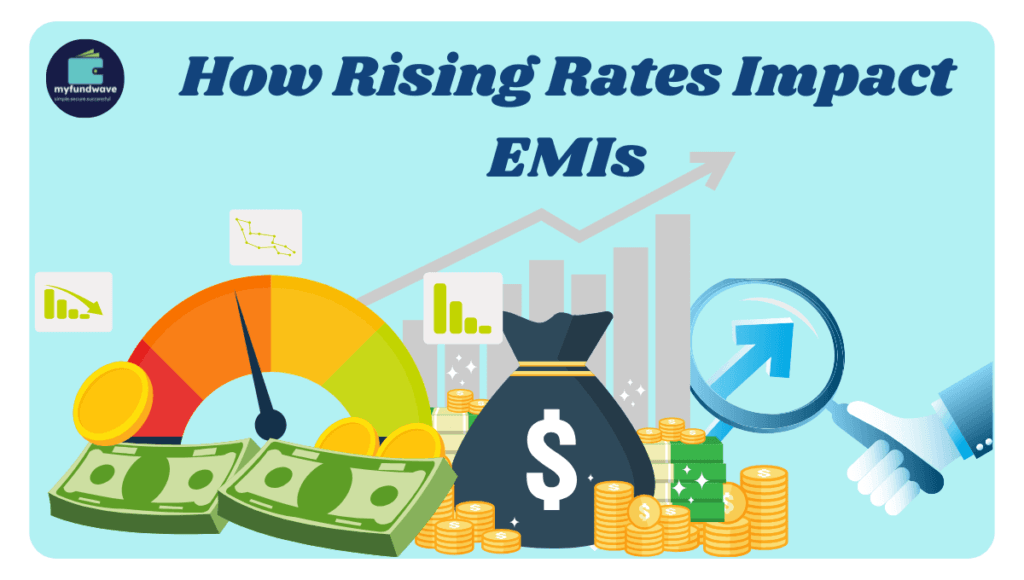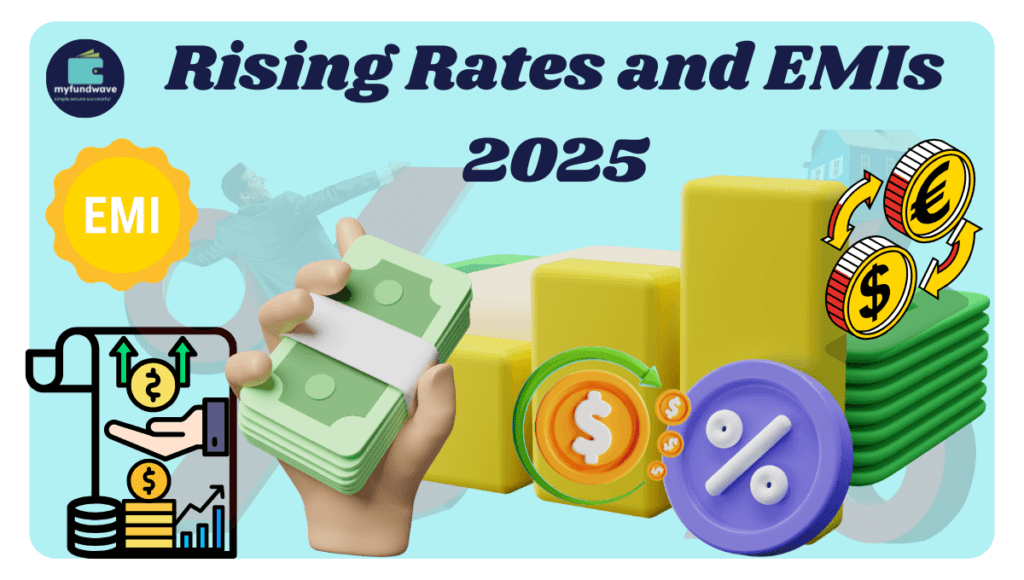Introduction
Rising Rates and EMIs have become a key concern for individuals managing their household budgets. These two factors significantly affect your monthly outflows, whether it’s a home loan, car loan, or personal loan.
If you’ve ever wondered how Rising Rates and EMIs work or how to navigate their impact on your finances, this blog covers everything you need to know. From the relationship between interest rates and EMIs to actionable strategies, we’ll guide you through the essentials of managing Rising Rates and EMIs effectively.
Table of Contents

What Are Interest Rates and EMIs?
Interest rates don’t change randomly. The Reserve Bank of India (RBI) adjusts them based on the country’s economic conditions. Here are two key reasons why rates increase:
- Inflation: When prices of goods and services go up (inflation), the RBI raises interest rates to control spending and reduce money supply.
- Economic Policies: If the RBI wants to stabilize the economy or attract foreign investments, it may increase rates.
For example, in recent years, the RBI has raised its repo rate (the rate at which it lends to banks). This leads to higher rates for loans like home, car, and personal loans. Rising Rates and EMIs

Why Do Interest Rates Rise?
Understanding why interest rates rise helps you grasp the reasons behind Rising Rates and EMIs. Key factors include
Inflation Control
RBI raises rates to control inflation, which means keeping prices of goods and services in check.
Economic Growth
To manage growth, RBI sometimes adjusts rates to encourage or discourage borrowing.
Global Factors
Changes in global markets can also push rates up.

How Rising Rates Impact EMIs
When interest rates increase, Rising Rates and EMIs directly affect your financial commitments. Here’s an example:
A home loan of ₹50 lakhs for 20 years at 7% results in an EMI of ₹38,765.
If the rate increases to 8%, the EMI rises to ₹41,822.
Over time, this can lead to much higher total repayments, highlighting the importance of managing Rising Rates and EMIs.

Types of Loans Affected by Rising Rates
Home Loans
Since home loans are usually long-term, even a small rate hike makes a big difference.
Personal Loans
These are already expensive, so higher rates mean higher monthly costs.
Car Loans
Rising rates can make buying a car on loan less attractive
Education Loans
Students or parents have to plan better as these loans get more expensive.

What Can You Do to Manage Rising EMIs?
Here are some tips to handle increasing EMIs effectively:
Increase Loan Tenure
You can extend the loan period to reduce your monthly EMI. However, remember that this increases the total interest you pay over time.
Prepay Your Loan
If you have extra savings, use them to prepay a part of your loan. This reduces both the loan amount and your EMI.
Switch to a Lower Interest Rate
Check if your bank offers better rates or refinance your loan with another lender.
Negotiate with Your Bank
Banks sometimes agree to reduce rates for loyal customers. It doesn’t hurt to ask.
Budget Smartly
Review your expenses and prioritize. Cut unnecessary spending to manage your EMI better.

How Rising Rates and EMIs Impact Everyday Life
Reduced Savings
When EMIs rise due to rising rates, people have less money left for savings. This can delay financial goals like buying a home or funding a child’s education.
Stress on Monthly Budgets
Higher EMIs make it harder to balance your monthly budget. Rising rates also make borrowing less affordable, forcing families to cut back on discretionary spending.
Need for Financial Planning
Rising rates and EMIs highlight the importance of financial planning. Managing your budget, choosing the right loans, and monitoring interest rate trends become essential.
Should You Avoid Loans Altogether?
Loans can be helpful for buying a home, starting a business, or funding education. However, taking unnecessary loans or overspending with credit cards can lead to trouble, especially when rates rise.

Benefits of Understanding EMIs and Interest Rates
Benefits of Understanding EMIs and Interest Rates
Knowing how interest rates affect EMIs helps you:
• Plan your finances better.
• Avoid defaulting on payments.
• Save more money in the long run.
• A Look at Fixed vs. Floating Interest Rates
When you take a loan, you have two options:
Fixed Rates
These remain constant throughout the loan period. Your EMIs won’t change, but fixed rates are usually higher than floating rates.
Floating Rates

Why Staying Informed Matters
Rising interest rates are a reality that borrowers must face. Staying informed about interest rates and EMIs can help you make smarter financial choices:
- Compare loan options before borrowing.
- Keep track of RBI announcements on interest rates.
- Regularly review your financial goals.
Conclusion
Rising rates and higher EMIs are becoming common challenges for borrowers. While higher EMIs can strain your budget, proactive steps like refinancing loans, building an emergency fund, and investing in safer options can help mitigate the impact of rising interest rates.
Understanding how rising rates and EMIs affect your finances is the first step toward achieving financial stability. With proper financial planning, informed decisions, and a disciplined approach to borrowing, you can navigate the challenges posed by increasing rates and secure your financial future.











